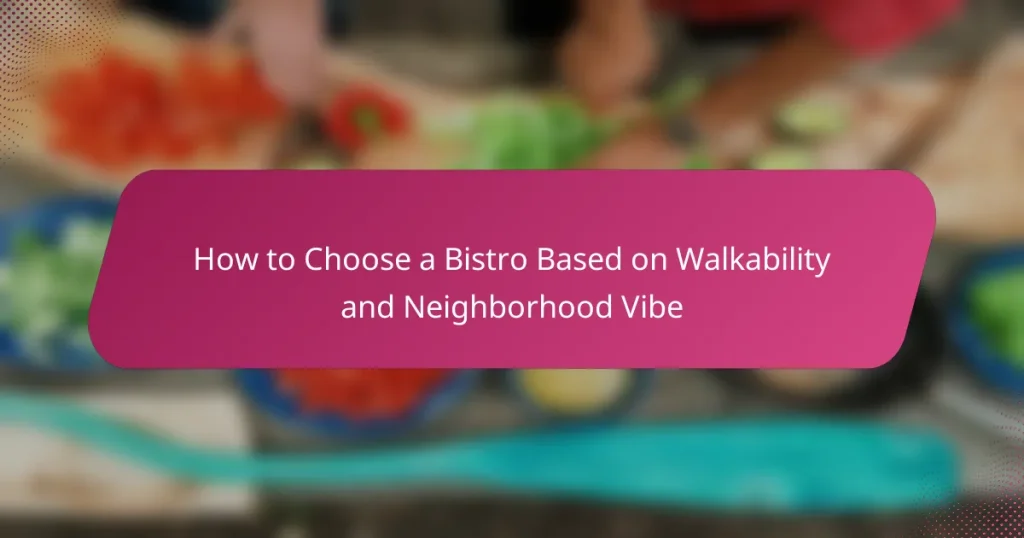Choosing the right bistro involves considering both walkability and the neighborhood vibe, as these factors greatly enhance your dining experience. A bistro in a walkable area not only offers easy access but also immerses you in the local culture and atmosphere. By evaluating the surrounding environment, including safety, noise levels, and nearby attractions, you can find a dining spot that perfectly aligns with your preferences.

How does walkability impact bistro selection in urban areas?
Walkability significantly influences bistro selection in urban environments by enhancing accessibility and creating a more enjoyable dining experience. A bistro located in a walkable area is more likely to attract customers who prefer to explore neighborhoods on foot, leading to increased foot traffic and a vibrant atmosphere.
Proximity to public transportation
Choosing a bistro near public transportation can greatly enhance convenience for diners. Locations within a short walk from bus or subway stations allow patrons to easily reach the venue without needing a car. Look for bistros that are within a few blocks of major transit lines to ensure easy access.
Additionally, consider the frequency of service. Bistros near high-frequency transit routes tend to attract more visitors, as customers appreciate the reduced wait times for their journey.
Ease of access for pedestrians
Pedestrian-friendly areas are essential for bistro selection, as they encourage walking and exploration. Look for bistros situated on streets with wide sidewalks, crosswalks, and minimal traffic interruptions. These features create a more pleasant experience for diners arriving on foot.
Check for nearby amenities like benches or outdoor seating, which can enhance the overall vibe and make the area more inviting for pedestrians.
Availability of bike lanes
Bistros located near dedicated bike lanes can attract cyclists, providing an alternative to driving or public transport. When selecting a bistro, assess the availability and quality of bike lanes leading to the location. Well-maintained lanes can make cycling safer and more appealing.
Some bistros may even offer bike parking or incentives for cyclists, such as discounts, which can further enhance their appeal to this demographic.
Safety of walking routes
The safety of walking routes to a bistro is a critical factor in its selection. Areas with well-lit streets, visible security, and low crime rates tend to encourage more foot traffic. Research local crime statistics and consider visiting the area at different times to gauge safety.
Additionally, check for traffic patterns; bistros located on quieter streets may provide a more comfortable walking experience compared to those on busy thoroughfares.
Neighborhood foot traffic
High levels of neighborhood foot traffic can indicate a vibrant atmosphere, making it an important consideration when choosing a bistro. Areas with shops, parks, and other attractions tend to draw more pedestrians, which can benefit nearby dining establishments.
Observe the time of day and week to understand peak foot traffic periods. Bistros in lively neighborhoods may enjoy increased patronage during lunch hours or weekend evenings, enhancing their potential for success.

What are the key neighborhood vibes to consider?
When choosing a bistro, understanding the neighborhood vibe is essential. Key factors include local culture, dining diversity, noise levels, and safety, all of which contribute to the overall experience.
Local culture and community events
Local culture significantly influences the atmosphere of a bistro. Look for neighborhoods that host regular community events, such as farmers’ markets or street fairs, which can enhance the dining experience. Engaging with local art, music, or seasonal festivals can also provide a unique backdrop for your meal.
Consider checking local calendars or social media pages to find out about upcoming events. A vibrant community often indicates a lively bistro scene, making it more enjoyable to dine out.
Dining scene diversity
A diverse dining scene suggests a rich culinary landscape. Look for neighborhoods that offer a variety of bistros, from casual eateries to upscale dining, reflecting different cuisines and styles. This variety can enhance your options and allow you to explore new flavors.
Researching local reviews or food blogs can help you identify popular spots and hidden gems. Aim for areas where bistros are known for their unique offerings, which can provide a more memorable dining experience.
Noise levels and ambiance
Noise levels and ambiance are crucial for a pleasant dining experience. Consider visiting during peak hours to gauge the typical noise level and overall vibe. Some bistros thrive in lively environments, while others may offer a more relaxed setting.
Pay attention to the interior design and layout, as these elements can affect how comfortable and inviting a bistro feels. A cozy atmosphere with appropriate lighting can enhance your meal, making it more enjoyable.
Safety and cleanliness
Safety and cleanliness are paramount when choosing a bistro. Look for well-maintained establishments in neighborhoods with low crime rates. Cleanliness can often be assessed through online reviews or by observing the bistro’s exterior and dining area.
Check for health department ratings if available, as these can provide insights into the bistro’s hygiene practices. A safe and clean environment not only ensures a pleasant meal but also contributes to your overall peace of mind while dining out.

How to evaluate bistros based on walkability?
To evaluate bistros based on walkability, consider the ease of access to the restaurant and the surrounding neighborhood’s vibe. A bistro that is easily reachable on foot, with nearby attractions and a pleasant atmosphere, enhances your dining experience.
Mapping nearby attractions
Identifying nearby attractions is crucial for assessing a bistro’s walkability. Look for parks, shops, or cultural sites within a short walking distance, ideally within 10-15 minutes. This not only makes your visit more enjoyable but also enriches the neighborhood experience.
Use online maps to visualize the area around the bistro. A concentration of attractions can indicate a vibrant neighborhood, making the bistro more appealing for a casual stroll before or after your meal.
Checking walk score ratings
Walk score ratings provide a quick assessment of how walkable a location is. These scores typically range from 0 to 100, with higher scores indicating better walkability. A score above 70 is usually considered very walkable, while scores below 50 suggest a car-dependent area.
Visit websites that offer walk score ratings to compare different bistros. This can help you choose a restaurant that not only serves great food but is also situated in a pedestrian-friendly environment.
Reading customer reviews
Customer reviews often highlight the walkability and neighborhood vibe of a bistro. Look for comments that mention the ease of access, safety, and overall atmosphere of the area. Reviews can provide insights into the experiences of others who have dined there.
Pay attention to recurring themes in reviews, such as mentions of nearby attractions or the friendliness of the neighborhood. This qualitative information can guide you in selecting a bistro that aligns with your preferences for walkability and ambiance.

What are the best neighborhoods for bistros in Los Angeles?
Los Angeles boasts several neighborhoods that are ideal for bistro dining, each offering unique walkability and atmosphere. Key areas include Downtown Los Angeles, Silver Lake, West Hollywood, and Santa Monica, each providing a distinct vibe and accessibility to various dining options.
Downtown Los Angeles
Downtown Los Angeles is a bustling hub with a vibrant culinary scene, making it a prime location for bistros. The area is highly walkable, with many restaurants situated within easy reach of public transportation and popular attractions.
Consider exploring the Arts District, where trendy bistros often feature outdoor seating and art-filled surroundings. Look for spots that offer a mix of casual and upscale dining to suit different occasions.
Silver Lake
Silver Lake is known for its eclectic vibe and diverse food options, making it a favorite among locals and visitors alike. The neighborhood is pedestrian-friendly, with many bistros located near parks and shopping areas.
When choosing a bistro in Silver Lake, pay attention to the ambiance and community events that often take place nearby. This can enhance your dining experience, especially if you enjoy a lively atmosphere.
West Hollywood
West Hollywood, or WeHo, is famous for its trendy lifestyle and vibrant nightlife, which extends to its bistro scene. The area is very walkable, with many eateries clustered along major streets like Santa Monica Boulevard.
Look for bistros that offer outdoor dining options, as the pleasant California weather allows for enjoyable meals al fresco. Additionally, consider checking out venues that host live music or art events to complement your dining experience.
Santa Monica
Santa Monica combines beachside charm with a lively bistro culture, making it an attractive destination for food lovers. The neighborhood is designed for walking, with many bistros located close to the beach and shopping areas.
When selecting a bistro in Santa Monica, consider those with ocean views or proximity to the pier for a picturesque dining experience. Be mindful of peak tourist seasons, as popular spots can get crowded, so making reservations is often a good idea.

How do bistro prices vary by neighborhood vibe?
Bistro prices can significantly differ based on the neighborhood vibe, influenced by factors such as location, demand, and local demographics. Generally, trendy or upscale areas tend to have higher prices, while more casual neighborhoods may offer more affordable options.
Trendy Neighborhoods
In trendy neighborhoods, bistros often cater to a clientele willing to pay a premium for ambiance and unique culinary experiences. Prices in these areas can range from mid to high, with main dishes typically costing between $20 and $50. The atmosphere is often lively, attracting both locals and tourists.
When choosing a bistro in a trendy area, consider the overall dining experience, including decor, service, and menu variety. Reservations may be necessary, especially during peak hours, as these spots can get crowded quickly.
Family-Friendly Areas
Bistros in family-friendly neighborhoods usually offer a more casual dining experience with prices that are generally lower. Main dishes in these locations might range from $10 to $25, making them accessible for families and larger groups. The vibe is often relaxed, with menus that cater to diverse tastes.
Look for bistros that provide kid-friendly options and a welcoming atmosphere. Many of these establishments may also offer specials or discounts for families, making dining out more affordable.
Upscale Districts
In upscale districts, bistro prices reflect the high-end market, with dishes often priced above $30. These establishments focus on gourmet ingredients and exceptional service, creating a refined dining experience. The vibe is typically sophisticated, attracting food enthusiasts and those celebrating special occasions.
When dining in an upscale bistro, be prepared for a more formal atmosphere and potentially higher service charges. It’s advisable to check for tasting menus or prix fixe options, which can provide better value for a multi-course meal.
Suburban Locations
Bistros in suburban areas often strike a balance between price and quality, with main dishes ranging from $15 to $30. These venues typically offer a comfortable setting that appeals to a wide demographic, including families and young professionals. The vibe is usually laid-back, making it a great spot for casual dining.
Consider visiting during off-peak hours for better deals or specials. Many suburban bistros also feature outdoor seating, enhancing the dining experience during pleasant weather.


